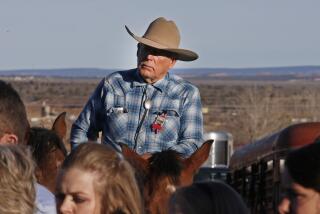Apparent suicide in anthrax case
A top government scientist who helped the FBI analyze samples from the 2001 anthrax attacks has died in Maryland from an apparent suicide, just as the Justice Department was about to file criminal charges against him for the attacks, the Los Angeles Times has learned.
Bruce E. Ivins, 62, who for the last 18 years worked at the government’s elite biodefense research laboratories at Ft. Detrick, Md., had been informed of his impending prosecution, said people familiar with Ivins, his suspicious death and the FBI investigation.
Ivins, whose name had not been disclosed publicly as a suspect in the case, played a central role in research to improve anthrax vaccines by preparing anthrax formulations used in experiments on animals.
Regarded as a skilled microbiologist, Ivins also helped the FBI analyze the powdery material recovered from one of the anthrax-tainted envelopes sent to a U.S. senator’s office in Washington.
Ivins died Tuesday at Frederick Memorial Hospital after ingesting a massive dose of prescription Tylenol mixed with codeine, said a friend and colleague, who declined to be identified out of concern that he would be harassed by the FBI.
The death -- without any mention of suicide -- was announced to Ivins’ colleagues at the U.S. Army Medical Research Institute of Infectious Diseases, or USAMRIID, through a staffwide e-mail.
“People here are pretty shook up about it,” said Caree Vander Linden, a spokeswoman for USAMRIID, who said she was not at liberty to discuss details surrounding the death.
The anthrax mailings killed five people, crippled national mail service, shut down a Senate office building and spread fear of further terrorism after the Sept. 11 attacks.
The extraordinary turn of events followed the government’s payment in June of a settlement valued at $5.82 million to a former government scientist, Steven J. Hatfill, who was long targeted as the FBI’s chief suspect despite a lack of any evidence that he had ever possessed anthrax.
The payout to Hatfill, a highly unusual development that all but exonerated him in the mailings, was an essential step to clear the way for prosecuting Ivins, according to lawyers familiar with the matter.
Federal investigators moved away from Hatfill -- for years the only publicly identified “person of interest” -- and ultimately concluded that Ivins was the culprit after FBI Director Robert S. Mueller III changed leadership of the investigation in late 2006.
The FBI’s new top investigators -- Vincent B. Lisi and Edward W. Montooth -- instructed agents to reexamine leads or potential suspects that may have received insufficient attention. Moreover, significant progress was made in analyzing genetic properties of the anthrax powder recovered from letters addressed to two senators.
The renewed efforts led the FBI back to USAMRIID, where agents first questioned scientists in December 2001, a few weeks after the fatal mailings.
By spring of this year, FBI agents were still contacting Ivins’ present and former colleagues. At USAMRIID and elsewhere, scientists acquainted with Ivins were asked to sign confidentiality agreements in order to prevent leaks of new investigative details.
Ivins, employed as a civilian at Ft. Detrick, earlier had attracted the attention of Army officials because of anthrax contaminations that Ivins failed to report for five months. In sworn oral and written statements to an Army investigator, Ivins said that he had erred by keeping the episodes secret -- from December 2001 to late April 2002. He said he had swabbed and bleached more than 20 areas that he suspected were contaminated by a sloppy lab technician.
“In retrospect, although my concern for biosafety was honest and my desire to refrain from crying ‘Wolf!’ . . . was sincere, I should have notified my supervisor ahead of time of my worries about a possible breach in biocontainment,” Ivins told the Army. “I thought that quietly and diligently cleaning the dirty desk area would both eliminate any possible [anthrax] contamination as well as prevent unintended anxiety at the institute.”
The Army chose not to discipline Ivins regarding his failure to report the contamination. Officials said that penalizing Ivins might discourage other employees from voluntarily reporting accidental spills of “hot” agents.
But Ivins’ recollections should have raised serious questions about his veracity and his intentions, according to some of those familiar with the investigation. For instance, although Ivins said that he swabbed areas near and within his personal office, and bleached surfaces to kill any spores, and that some of the swabs tested positive, he was vague about what should have been an essential next step:
Reswabbing to check whether any spores remained.
“I honestly do not recall if follow-up swabs were taken of the area,” Ivins said. “I may have done so, but I do not now remember reswabbing.”
“That’s bull----,” said one former senior USAMRIID official. “If there’s contamination, you always reswab. And you would remember doing it.”
The former official told The Times that Ivins might have hedged regarding reswabbing out of fear that investigators would find more of the spores inside or near his office.
Ivins’ statements were contained within a May 2002 Army report on the contamination at USAMRIID and was obtained by The Times under the Freedom of Information Act.
Soon after the government’s settlement with Hatfill was announced June 27, Ivins began showing signs of serious strain.
One of his longtime colleagues told The Times that Ivins, who was being treated for depression, indicated to a therapist that he was considering suicide.
Soon thereafter, family members and local police officers escorted Ivins from USAMRIID, where his access to sensitive areas was curtailed, the colleague said.
Ivins was committed to a facility in Frederick for treatment of his depression. On July 24, he was released from the facility, operated by Sheppard Pratt Health System. A telephone call that same day by The Times verified that Ivins’ government voice mail was still functioning at the bacteriology division of USAMRIID.
The scientist faced forced retirement, planned for September, said his longtime colleague, who described Ivins as emotionally fractured by the federal scrutiny.
“He didn’t have any more money to spend on legal fees. He was much more emotionally labile, in terms of sensitivity to things, than most scientists. . . . He was very thin-skinned.”
FBI spokeswoman Debra J. Weierman said Thursday that the bureau would not comment on the death of Ivins.
Last week, FBI Director Mueller told CNN that “in some sense, there have been breakthroughs” in the case.
“I’ll tell you we made great progress in the investigation,” Mueller added.
“And it’s in no way dormant.”
Ivins, the son of a Princeton-educated pharmacist, was born and raised in Lebanon, Ohio, and received undergraduate and graduate degrees, including a doctorate in microbiology, from the University of Cincinnati.
The eldest of his two brothers, Thomas Ivins, said he was not surprised by the events that have unfolded.
“He buckled under the pressure from the federal government,” Thomas Ivins said, adding that FBI agents came to Ohio last year to question him about his brother.
“I was questioned by the feds, and I sung like a canary” about Bruce Ivins’ personality and tendencies, Thomas Ivins said.
“He had in his mind that he was omnipotent.”
Ivins’ widow declined to be interviewed when reached Thursday at her home in Frederick. The couple raised twins, now 24.
The family’s home is 198 miles -- about a 3 1/2 -hour drive -- from a mailbox in Princeton, N.J., where anthrax spores were found by investigators.
All of the recovered anthrax letters were postmarked in that vicinity.
--
Willman reported from Los Angeles and Washington. Times researcher Janet Lundblad contributed to this report.
More to Read
Start your day right
Sign up for Essential California for news, features and recommendations from the L.A. Times and beyond in your inbox six days a week.
You may occasionally receive promotional content from the Los Angeles Times.







